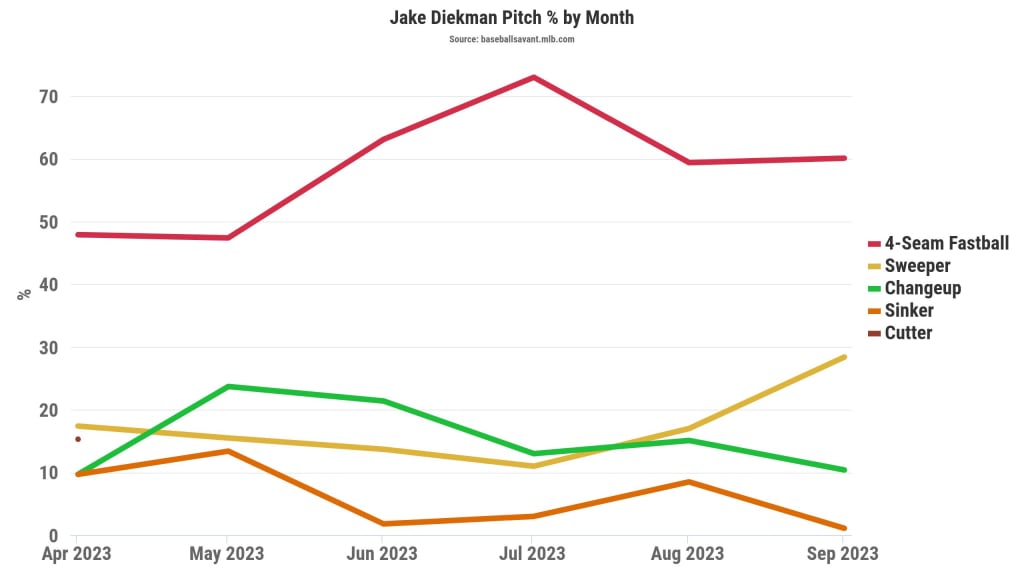PORT ST. LUCIE, Fla. -- During one of his first bullpen sessions as a Met on Saturday, reliever Jake Diekman developed a pattern. He would throw a pitch, then look over his shoulder, frequently stepping off the mound to consult a tablet computer. Often, he and a nearby coach observed together, seeking answers from the tech.
Although Diekman is 37 years old and a veteran of a dozen big league seasons, his career took a sharp turn last year when the White Sox traded him to the Rays. In Tampa Bay, Diekman became yet another success story for a franchise well-versed in transforming relievers. He stopped throwing his sinker and cutter, focusing instead on his four-seam fastball, sweeper and changeup. Beyond that, Diekman learned how to shape those pitches in optimal ways.
Now with the Mets after signing a $4 million contract late in the offseason, Diekman understands his body and mechanics better than ever. In these early days of Spring Training, he is using technology as a crutch to make sure his shoulder, elbow and hand are all where they need to be throughout his delivery.

“When you’re young, I don’t know if it’s the best thing,” Diekman said. “But when you’re older and you have more body control and can tweak stuff here and there -- and you kind of know what to do with the information -- I feel like it’s a lot easier.”
Over the first 11 seasons of his career from 2012-22, Diekman established himself as a solid but inconsistent reliever for seven different teams, producing a 3.87 ERA and a 109 ERA+ that suggested he was a shade above average. But he struggled so mightily over five weeks with the White Sox last year, posting a 7.94 ERA across 11 1/3 innings, that the team released him. The Rays, sniffing talent, signed Diekman four days later and remade him into this current version. The rest of the way, Diekman had a 2.18 ERA and 192 ERA+.
“They know what they’re doing over there,” Diekman said. “I mean every organization does now. But they just find a strength and tell you how it can be better.”
Diekman’s presence gives the Mets a luxury they rarely enjoyed last year: two left-handers in the bullpen. He will split high-leverage situations with another former Ray, Brooks Raley.
He ain't heavy, he's my brother
Among the several prospects attending their first Mets camp is Luisangel Acuña, who at the moment is best known as the little brother of the reigning National League MVP, Ronald Acuña Jr. The younger Acuña traveled to New York for the first time in January to watch his brother receive that award at the Baseball Writers’ Association of America New York chapter dinner.
“It gave me goosebumps, because not everybody wins an MVP,” Luisangel said through an interpreter. “So to see my brother win it, it was something really special.”
Now that the brothers have parted ways, however, Luisangel’s goal is to separate himself from Ronald’s shadow. The younger Acuña, who came over from the Rangers in the Max Scherzer trade last July, is a blue-chip prospect in his own right. He stole 57 bases last year at Double-A and earned a spot on MLB Pipeline's preseason Top 100 list at No. 66.
“I don’t think it’s fair for him to put that type of pressure,” Mets manager Carlos Mendoza said. “For him to compare to Ronald Acuña, obviously he’s a special player, right? But we know the talent’s there. It’s important for him to understand who he is as a player and then stick to it.”
Acuña, who turns 22 in March, believes his best asset is his defense. A natural shortstop, Acuña figures he will wind up at second base since Francisco Lindor is entrenched at the former position. He’s also comfortable in center field, where he played four games last year, but the Mets have no current plans to use him in the outfield.
On the mend
Reliever Kyle Crick, who is in camp on a Minor League deal, is wearing a walking boot around the clubhouse as he recovers from a Grade 4 calf strain -- the most severe variety. Crick has had the area drained multiple times and will require at least a month to recover. He’s hopeful he can at least begin throwing bullpen sessions before the end of camp.
Once healthy, Crick has no qualms about detouring to Triple-A Syracuse in hopes of returning to the big leagues for the first time since June 2022. In the meantime, the six-year veteran says he’s enjoying being a mentor to some of the younger players in camp.


